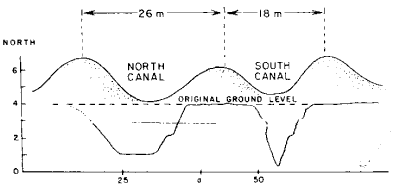 |
Science Frontiers ONLINE No. 31: Jan-Feb 1984 |
|
|
Phoenix vs. the hohokam
Rapidly expanding Phoenix is gobbling up the vestiges of the Hohokam. Archeologists are striving to save as much information as possible before the bulldozers destroy the best artifacts left by this remarkable Indian civilization. This beautifully illustrated article touches on several of the precocious and puzzling features of the Hohokam Period, circa 0-1,400 AD.
(1) The Hohokam apparently employed acid-etching to produce designs on shells. Acetic acid from fermented cactus juice was use to eat away portions of the shell not protected by tar. (2) Four-story Casa Grande, which seems to have been an astronomical observatory, required at least 600 big wooden beams, all of which had to be transported over 50 miles from sources in the mountains. (3) The Hohokam built an elaborate, well-engineered system of irrigation canals. (4) Unexplained are many flat-bottomed oval pits up to 182 feet long, 55 feet wide, and 13-18 feet deep. Some surmise they were ball courts. (5) Also puzzling are rectangular earthen mounds, 75 x 95 feet at the base and 12 feet high, with flat adobe-covered tops.
(Adams, Daniel B.; "Last Ditch Archeology," Science 83, 4:28, December 1983.)
Reference. The Hohokam canals and those built by other ancient peoples are presented in our Handbook Ancient Man. For details on this book, visit: here.
 | Section through two Hohokum canals, showing original canal profile (bottom) and final profile after long use. Sedimentation eventually raised the canal bottoms above the original ground level. (Illustration from Ancient Man) |